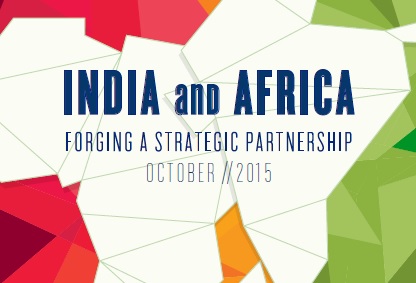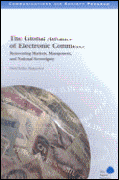Content from the Brookings Institution India Center is now archived. After seven years of an impactful partnership, as of September 11, 2020, Brookings India is now the Centre for Social and Economic Progress, an independent public policy institution based in India.
The chapter is part of a briefing book ‘India and Africa: Forging A Strategic Partnership’ edited by Dr. Subir Gokarn, Dr. WPS Sidhu and Shruti Godbole.
Trade Relations
There are three elements to India’s trade relations with Africa – increasing the volume of imports and exports between the two countries; government support to the private sector; and the diverse nature of India’s economic engagements, both government and private, with Africa.
Bilateral trade jumped from $5.3 billion in 2001 to $12 billion in 2005 to $70 billion in 2013, which is greater than India’s bilateral trade with the U.S. African exports to India have been growing annually at 32.2% while Indian exports to Africa grew annually at 23.6%. By 2015 it was expected that bilateral trade would increase to $90 billion. According to a report released by the Confederation for Indian Industry and the World Trade Organisation in 2013, if the annualised growth rates between 2001 and 2011 continued then bilateral trade was forecasted to reach $176 billion by 2015 (Figure 1). During the sidelines of the World Economic Forum last year held in New Delhi, African leaders and Indian industrialists announced their joint visions to achieve US$500 billion in trade between Africa and India by 2020 – this is almost five times more than what was projected for 2015.

Much of this increase in trade can be attributed to the steps taken by the Indian government over the years, as well as the initiatives of the private sector in establishing their presence in African countries. There have been nine India-Africa Conclaves organised by Cl I since the first Conclave held in New Delhi in 2005 and the participants as well as project opportunities have grown considerably. At the second India-Africa Forum Summit in 2011, India stated it would extend LOCs (Lines of Credits) worth $5-4 billion until 2014 to support the developmental requirements of its African partners. The triennial Summits, the first of which was in 2008, recognize the growing importance of India-Africa ties and bring together the highest leadership from India and African countries for a structured political and economic interaction. In 2008, India made the announcement of granting duty-free tariff preference to Least Developed Countries (LDCs).
The ‘India-Africa Trade Ministers Dialogue’ is an annual event, since the first one held on May 2011 on the occasion of the 2nd Africa-Inidia Forum Summit held at Head of State level. The ministerial dialogue discusses trade-related bilateral issues and assesses the progress of development co-operation set forward in Africa-India Forum Summits. Launched in 2002, the Focus Africa Programme initially focused on sub-Saharan Africa with emphasis on seven major trading partners in the region: Ethiopia, Tanzania, Nigeria, South Africa, Mauritius, Kenya and Ghana. Together these countries accounted for 69 per cent of India’s trade in sub-Saharan Africa. The programme broadened in 2003 to add 17 more countries, including those in North Africa.
Imports and Exports
African exports to India are growing at a rate of 32 per cent annually, with Indian exports to Af rica at a rate of 23 per cent. The top six African exporters to India are Nigeria, South Africa, Angola, Egypt, Algeria and Morocco and ac count for 89 per cent of total African exports by value to India, mainly due to exports of oil, gas, ores and gold. Trade is significantly more diversified across African countries at the product level and all exports from India seem to have some degree of technological input.
India currently faces an energy deficit and coupled with potential supply insecurity from other regions, Africa’s role as a supplier of minerals and fuels may intensify in the short run. Africa now supplies around a fifth of India’s total crude oil imports, having risen from nearly zero in 2005. In terms of product specialization, crude oil and gas account for over two-thirds of exports to India while gold and other precious metals account for 16 per cent. The top six products are crude oil (60%), gold (15%), phosphoric acid (3.8%), liquefied natural gas (2.7%) and shelled cashew (2.6%) – which account for over 87 per cent of total African exports to India (CII/WTO 2013).
African nations have also benefitted from India’s Duty Free Tariff Preference (DFTP-LDC) scheme for least developed countries (LDCs) – this scheme was implemented in 2008 over a period of five Under the scheme, prior to its revision in August 2014, LDCs were of fered duty-free access on 85 per cent of Indi an tariff lines; this was extended to 98 per cent following the revision.
Challenges for India’s trade relationship with Africa
The major challenges faced by exporters and importers from India and Africa are primarily: transport and logistics costs; poor business environment (lack of ease of doing business); corrupt practices; and access to trade finance.
Transport and logistics costs are considered to be of greater importance to Indian exports to Africa. Most Indian exporters, due to high shipping costs and insurance costs prefer to sell their goods on a ‘free on-board’ basis instead of ‘on-delivery’ (CII/WTO 2013). In this case, the risk of loss transfers on to the buyer – Indian exporters are risk averse due to the high transaction costs associated with exporting to Africa. Indian exporters also cite poor business environment and lack of access to buyers as another major impediment in trade, especially in exporting services to African Firms find it difficult to acquire the necessary visas and permits required to set up operations in Africa. This is particularly important for information technology firms who are looking to partner with and expand operations in the African continent.
Investment opportunities and challenges
India’s Investments in Africa
Africa today is seen as the one of the largest untapped potential destinations for investments due to its rich natural resources. The continent is the third-fastest growing economic region in the world with a rate of urbanization higher than that of India. In this regard, Indian investments in the region have seen an upward trend in recent years; investments have grown substantially across the African continent and sectors. Today, Indian multinational enterprises (MNEs) present in Africa range from energy to mining to telecommunications to IT-enabled services.
From the Indian perspective the key sectors are agriculture, healthcare and pharmaceuticals, textiles, automobiles, banking and financial services, information technology, energy and infrastructure. India today is the fifth largest investor in Africa. According to estimates by the International Monetary Fund (IMF), Indian investment in Africa, in less than a de cade, rose from US$9.2 billion to US$14.1 billion in 2011, which accounts for 22.5 per cent of Indian outward foreign direct investment flows.
Indian firms in Africa sometimes acquire established businesses and are less vertically integrated – they procure supplies locally or from international markets and engage in sales to private African entities. India’s growing energy needs have pushed it towards energy cooperation with African countries as a source of raw materials and energy sources. Indian national oil companies such as the Oil and Natural Gas Corporation Videsh Limited (ONGC) have invested equity assets in Sudan, Ivory Coast, Libya, Egypt, Nigeria, Nigeria – Sao Tome and Principe Joint Development Area, and Gabon. Private sector companies such as Reliance have also invested in equity oil in Sudan, while Essar has procured exploration and production blocks in Madagascar and Nigeria.
In 2009, India completed a multi-million dollar project to lay a pipeline from Khartoum to Port Sudan in the Red Sea. In 2007 and 2009, the Indian Ministry of Petroleum and Natural Gas and chambers of commerce joined to organize the India-Africa Hydrocarbons Conferences to boost India’s investment in Africa’s energy sector. During the 2009 India-Africa Hydrocarbons Conference, India identified five main areas of cooperation with African countries: buying more crude oil from Africa; investing more in upstream opportunities based on bilateral basis; exploring opportunities to source more liquefied natural gas Africa, making available India’s skills; talent and technology in cost-effective ways for the benefit of Africa and supporting community development programmes in Africa so as to ensure inclusive growth.



Apart from hydrocarbons, the metals conglomerate Vedanta Resources has invested millions in Zambian copper mines; and the Parliament of Liberia ratified a 25-year deal allowing ArcelorMittal to launch a billion-dollar iron ore mining project. Tata Steel invested in a ferro-chrome project in Richards Bay, South Africa. In 2007, the Indian Farmers Fertilizer Cooperative signed a MOU with the Senegalese government to revive a phosphoric acid plant. The table below shows select Indian investments to Africa in recent years. The Tata Group have had a presence in Africa since the 1970s in the transport, information technology, hotels, mining and telecom sectors. Indian MNEs have also ventured into Greenfield and Brownfield investments, spanning telecommunications, energy, computer services, power and the automobiles sectors. Indian investments stock in Africa in 2008-09 stood at above $9.2 billion, while IMF estimates that total investments at the end of 2011 in Africa were $14.1 billion.
Africa’s investments in India
Mauritius is the largest investor in India with total FDI inflows of $64.17 billion. Mauritius accounts for 40 per cent approximately of total FDI inflows India, reflective of the tax treaty between the two countries. In terms of direct bliateral flows, Morocco and South Africa are the next largest investors with investments worth $137 million and $112 million, respectively. Investments from South Africa have been growing at a steady pacy with Tiger Brands, Airports Company South Africa & Bidvest, SAB Miller, FirstRand Bank, Standard Bank, Old Mutual, Balela Leisure, Anglo-American, Sasol and Nandos Group Holdings having made investments in the Indian market. Morocco has also invested in the manufacture of phosphate in India. ZuariMarocPhorphore holds 74 per cent stake in the earlier state-run Paradeep Phosphate Ltd.
Outward FDI flow from African countries have steadily grown from $1.5 billion in 2000 to $7 billion in 2010 before falling to $3.5 billion in 2011. A substantial portion of the outward FDI is intra-African and emanated from a few countries, including Zambia, Angola, Egypt and South Africa.
The Make-in-India initiative has been received favourably by African countries as an opportunity to boost investment. Companies can source materials from Africa, Make the products in India and then sell them in Africa. The African market is expected to expand to $1-4 trillion by 2020, up from $860 billion in 2008. This poses great opportunities for both India and Africa to boost trade and investment relations.
The Indian government has taken significant steps in preparing the Indian private sector to look to Africa for investment opportunities and contribute to value addition and economic growth on the continent. India’s broad-based investment approach can help compliment the trade growth between India-Africa, and help expand the range of goods and services traded between the two. In order to further investments and achieve common goals of development, there is a need to remove bottlenecks such as protection of investments, access to capital and an improved business environment.







